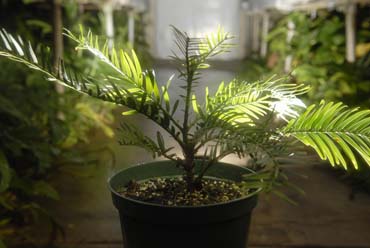UW-Madison acquires rare plant from dinosaur age
A relic plant that once co-existed with dinosaurs has taken up residence in the University of Wisconsin–Madison botany greenhouses.

Thanks to a worldwide effort to conserve and propagate the Wollemi pine—one of the oldest and rarest tree species on earth—a recently purchased foot-tall Wollemi seedling now has a home at the UW–Madison botany greenhouses at Birge Hall. The relic tree species, dating back 90 million years to the age of the dinosaurs and once known to botanists only through fossils, was discovered in an Australian national park in 1994. A limited number of the plants just became available in the United States through National Geographic.
Photo: Jeff Miller
Known as the Wollemi pine, the plant was presumed extinct until a “bushwalker” named David Noble discovered it in an Australian national park in 1994. As part of a worldwide effort to conserve and propagate the tree species — one of the oldest and rarest on earth — botany greenhouse director Mo Fayyaz recently purchased a foot-tall Wollemi pine seedling. A limited number of the plants just became available in the United States through National Geographic.
Fayyaz says the ancient conifer will be used to teach students about topics such as plant diversity, evolution and geography. The discovery of this “living fossil” also underscores the importance of conserving the world’s natural areas, he says, which can still hold unexpected treasures.
Before 1994, botanists knew the Wollemi pine only from fossils, the oldest of which date back 90 million years to the age of the dinosaurs. Scientists also believed the tree had gone extinct more than 2 million years ago. Although it has been dubbed a “pine,” the plant’s closest living relatives are not true pines, but other unusual conifers such as the Norfolk Island pine and monkey puzzle tree.
Fewer than 100 mature Wollemi pines currently exist in the wild, all within the same remote and rugged canyon of the Wollemi National Park near Sydney, Australia, from which the tree gets it name. The tallest pines in the park top 100 feet and some are estimated to be more than 1,000 years old.
To aid the plant’s continued survival, Fayyaz and his staff eventually plan to propagate their tree through cuttings. Although Fayyaz expects the pine to grow by one to two feet each year, its cultivation is an experiment. “As far as the growth and development of this plant goes, it’s all new to us,” he says.
The public can view the plant in the UW–Madison botany greenhouses, located in Birge Hall, anytime after Tuesday, Jan. 30. The greenhouses are open from 8 a.m.-4 p.m., Monday-Friday. During the summer months, Fayyaz may also move the Wollemi pine outside to the Botany Garden.




